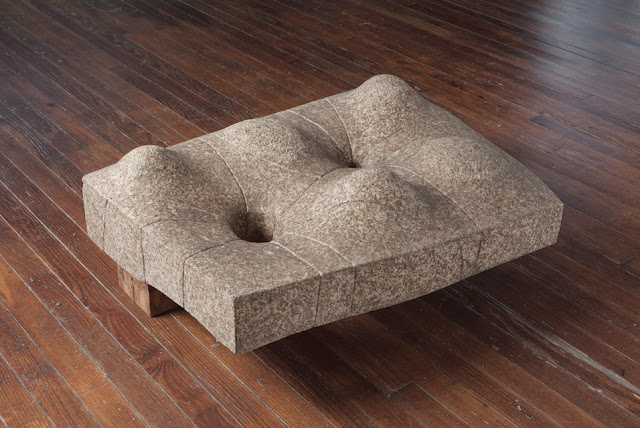Isamu Noguchi, Lunar Table, 1961-65, granite. The Isamu Noguchi Foundation and Garden Museum, New York. Photo by Kevin Noble. © The Isamu Noguchi Foundation and Garden Museum, New York.
Isamu Noguchi (1904–1988) was among the most innovative American sculptors of the 20th century. His design for “Sculpture to Be Seen from Mars” (1947) anticipates the space age by several decades. Even as he created works that were far ahead of his time, Noguchi frequently found inspiration in ancient art and architecture—from Egyptian pyramids and Buddhist temples to Zen gardens and American Indian burial mounds. “Isamu Noguchi, Archaic/Modern” explores how the ancient world shaped this artist’s vision for the future.
“Isamu Noguchi, Archaic/Modern” is on view in the museum’s main building from Nov. 11 through March 19, 2017. Dakin Hart, senior curator at The Noguchi Museum, and Karen Lemmey, curator of sculpture at the Smithsonian American Art Museum, organized the exhibition. The Smithsonian American Art Museum is the sole venue for this exhibition, which is expanded from an earlier installation at The Noguchi Museum.
“Isamu Noguchi—born in Los Angeles, raised and educated in Japan, Indiana, New York and Paris—was among the first American artists to think like a citizen of the world,” said Betsy Broun, The Margaret and Terry Stent Director of the Smithsonian American Art Museum. “The exhibition is the latest in a series of major shows to examine the contributions of such international artists as Nam June Paik, Christo, Yasuo Kuniyoshi and Tamayo, and their broad perspectives.”
“Isamu Noguchi, Archaic/Modern” brings together 74 works, nearly all on loan from The Noguchi Museum, made during the artist’s six-decade career. The artworks reflect Noguchi’s striving for timelessness through the abstraction of things, places and ideas. Featured works—including several monolithic basalt sculptures, fountains, designs for stage sets and playgrounds and floating Akari light sculptures—are organized in themes of particular interest to Noguchi: landscape, invention, the atomic age, outer space and social spaces. Noguchi saw himself as both artist and inventor, and the exhibition devotes special attention to his patented designs, such as “Radio Nurse,” the first baby monitor.
“The juxtaposition of the terms ‘archaic’ and ‘modern’ is an attempt to fold space-time in a way that is true to Noguchi’s attempts to make the practice of sculpture an expression of relativity in the modern, Einsteinian sense,” said Hart. “Noguchi exists somewhere in the fusion of these two abstract notions of time, and my hope is that by exhibiting his sculptures in thematic groupings we add to the scope of their meaningfulness and highlight the adaptability of Noguchi’s values to the future.”
“Noguchi’s work—which encompasses tradition and progress, the timeless and the modern— still resonates with contemporary audiences despite being created decades ago,” said Lemmey. “It is particularly wonderful to see the museum’s ‘Grey Sun,’ which was a gift from Noguchi, in this broader context that shows how ahead of his times Noguchi was with his unique perspective on global culture.”
“Isamu Noguchi—born in Los Angeles, raised and educated in Japan, Indiana, New York and Paris—was among the first American artists to think like a citizen of the world,” said Betsy Broun, The Margaret and Terry Stent Director of the Smithsonian American Art Museum. “The exhibition is the latest in a series of major shows to examine the contributions of such international artists as Nam June Paik, Christo, Yasuo Kuniyoshi and Tamayo, and their broad perspectives.”
“Isamu Noguchi, Archaic/Modern” brings together 74 works, nearly all on loan from The Noguchi Museum, made during the artist’s six-decade career. The artworks reflect Noguchi’s striving for timelessness through the abstraction of things, places and ideas. Featured works—including several monolithic basalt sculptures, fountains, designs for stage sets and playgrounds and floating Akari light sculptures—are organized in themes of particular interest to Noguchi: landscape, invention, the atomic age, outer space and social spaces. Noguchi saw himself as both artist and inventor, and the exhibition devotes special attention to his patented designs, such as “Radio Nurse,” the first baby monitor.
“The juxtaposition of the terms ‘archaic’ and ‘modern’ is an attempt to fold space-time in a way that is true to Noguchi’s attempts to make the practice of sculpture an expression of relativity in the modern, Einsteinian sense,” said Hart. “Noguchi exists somewhere in the fusion of these two abstract notions of time, and my hope is that by exhibiting his sculptures in thematic groupings we add to the scope of their meaningfulness and highlight the adaptability of Noguchi’s values to the future.”
“Noguchi’s work—which encompasses tradition and progress, the timeless and the modern— still resonates with contemporary audiences despite being created decades ago,” said Lemmey. “It is particularly wonderful to see the museum’s ‘Grey Sun,’ which was a gift from Noguchi, in this broader context that shows how ahead of his times Noguchi was with his unique perspective on global culture.”
